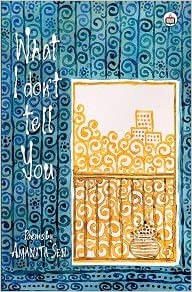Basudeb reviews a poetry anthology, What I Don’t Tell You, by Amanita Sen, a Naturalistic poet. An exclusive for Different Truths.
 Sen, Amanita, What I don’t tell you.
Sen, Amanita, What I don’t tell you.
Calcutta: Authorspress, 2019. 79pp.
Some twentieth century artists often employ the technique of Naturalism in their domains to be apparently dispassionate, withdrawn or impartial in sequencing events of life or mode of expressions in their creative works. They seem to be objective in delineating the facts of life as they are. In the arrangements of the facts of life in their art, those creative writers often look to be photographic presenters of the realities of life. John Galsworthy says that Naturalistic art is “like a steady lamp, held up from time to time, in whose light things will be seen for a space clearly, and in due proportion, freed from the mists of prejudice and partisanship”. But is it possible for those artists to be objective in their strategy? There cannot be any water tight compartment between the subjectivity and objectivity. Were Emile Zola, Ibsen or Galsworthy, Even Harley Granville Barker, or George Barnard Shaw objective?
Amanita Sen is a modern poet in Indian English, who arrests the attention of her readers by her strategic employment of Naturalistic imageries in her poems of this present anthology.
Amanita Sen is a modern poet in Indian English, who arrests the attention of her readers by her strategic employment of Naturalistic imageries in her poems of this present anthology. Amanita strategies to foreground her feelings through naturalistic imageries and those imageries spark off readers’ senses. Audio visual clarity is one of the major characteristic features of her poems. The poem, Your Hand, introduces an apparently innocent image of flowing that looks like an ‘odyssey’ with your [his] healing hands. The damsel is in distress. She is not blessed. She is in need of [his] your hand. The re-reading of the first stanza creates a primitive and archetypal visual image.
The poem, My Body at Midnight, begins with a naturalistic image of “nature silently singing of the song of the Universe”, the song makes the narrator’s “body awake to it”. A careful reading of these five lines seems to be neutral and totally innocent but the nuance of these Naturalistic imageries, one finds in several poems, reveals poet’s state of mind.
Deep sea signifies two persons are desperate to help each other but they cannot…. A feeling of alienation is present in the narrator’s mind in moment of crises.
Another poem, Highway-run, begins with a simple and vivid description of the sea [that is not near the shore,] leads readers to “Deep inside the sea”. Deep sea signifies two persons are desperate to help each other but they cannot. The narrator is not a “mermaid skimming, floating, holding your [his] hand”. A feeling of alienation is present in the narrator’s mind in moment of crises.
The first stanza of five lines in My Regret-box is a fine example of a visual image for its plain statement in prose. Last night the narrator opens the regret-box to make way for those new. The unique argument the poet presents here is based on the nostalgic bent of the poet’s mind. But the narrator presents one piece of argument that seems to be in conjunction with the demand of the Time. The use of rhetoric in succession in the poems, and at the same time, the glaring absence of the deliberative rhetoric makes the poems of this anthology open-ended. In no way, the poems are persuasive or dissuasive. The problem in the naturalistic treatment of poetic visuals, the poet very often creates an illusion of life, but sometimes the poet carries his or her naturalism so far that he becomes almost photographic with the result that the poetic requirements suffer. Some of Sen’s poems have these definite limitations.
The second most important feature of these poems is the quality of urbanity in this anthology. All these poems are in first person narrative. The revelation of the narrator’s mind in the poems is conspicuous.
The second most important feature of these poems is the quality of urbanity in this anthology. All these poems are in first person narrative. The revelation of the narrator’s mind in the poems is conspicuous. The poem Vulnerability, December Lights, There is Home, The Incongruities, Packing, My Ten-year Old Jeans are the examples of urban poetry among many others in this anthology. Another feature of the urban poetry is the daylight presence of nostalgia and love for the past. The poem, If Not for These…, is a beautiful short poem that showcases urban mindset of the narrator. The first sentence of all these three stanzas would have been possible if one particular condition appearing in the second and the third line would have been absent. The idea, explicitly expressed in this poem, is typically urban in the context of twenty-first century Indian poetry in English.
anthology. All these poems are in first person narrative. The revelation of the narrator’s mind in the poems is conspicuous. The poem Vulnerability, December Lights, There is Home, The Incongruities, Packing, My Ten-year Old Jeans are the examples of urban poetry among many others in this anthology. Another feature of the urban poetry is the daylight presence of nostalgia and love for the past. The poem, If Not for These…, is a beautiful short poem that showcases urban mindset of the narrator. The first sentence of all these three stanzas would have been possible if one particular condition appearing in the second and the third line would have been absent. The idea, explicitly expressed in this poem, is typically urban in the context of twenty-first century Indian poetry in English.
Precision and economy of words in the poems of this book is very much attention calling. I do not say that this sense of precision and of word economy is found in all the poems of this anthology. But the poem, Midnight, as an example, mentioned to this context, the first stanza, “When you ask me/to write on “midnight”,/did you see my senses/and barely mumble,/”I sleep at mid-nights?” seems to be incorrigible for the deletion or addition to any word. The entire stanza enables readers to visualize an image of the narrative barely mumbling. The last line “I sleep at mid-night” is not innocent and close ended. The intended meaning of this sentence reaches the ears of the audience. There may be a mark of excess of feelings in this poem. It could be gem of a short lyric had it been only of six lines or only of the first stanza. “I sleep at mid-night” is the absolute or final. This line occurs again in the last stanza. The concluding stanza of the poem may or may not present with certain linking word or words between the two stanzas. In between these two stanzas, the 2nd, 3rd and 4th could have been absent.
The anthology of poems, entitled “What I Don’t Tell You” successfully rearticulates the Naturalistic imagery revival of the 19th and twentieth-century English literary technique in the second decade of the 21st century Indian poetry in English.
The anthology of poems, entitled “What I Don’t Tell You” successfully rearticulates the Naturalistic imagery revival of the 19th and twentieth-century English literary technique in the second decade of the 21st century Indian poetry in English. The taste of the poems in this anthology is varied and interesting.
Photo from the Internet





 By
By
 By
By

 By
By
wonderful review. wish the poet more success.